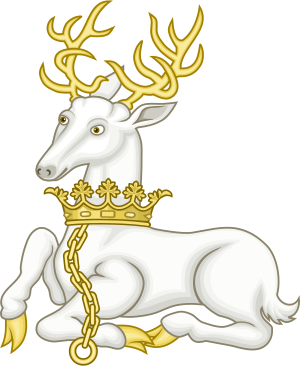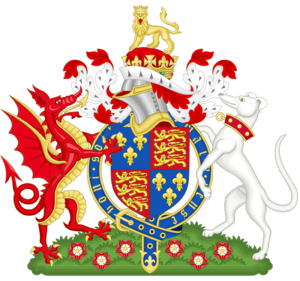Royal standards of England facts for kids
The royal standards of England were special flags used by the kings and queens of England. These flags were long and narrow, with a unique swallow-tailed shape. They were mainly used to gather troops for battle, in grand parades, and at funerals.
These flags were very popular during the Tudor period (around the 15th and 16th centuries). A Royal English Standard was different from the Royal Banner of England, which showed the king's coat of arms. Instead, the standard had the St George's Cross at one end. The rest of the flag showed different symbols, like animals or plants, and a motto. It did not show the main coat of arms. The design of the Royal Standard often changed with each new ruler. However, it usually kept the motto Dieu et mon droit, which means "God and my right."
In medieval times, the standard was like a modern-day headquarters flag. The leader's tent would be pitched under it. Soldiers would follow it into battle and gather around it to regroup. It was also where they would make their final stand. By the Tudor period, armies became more organized. The standard was then mostly used for ceremonies, not for fighting. Only people with special permission could fly them.
Contents
Types of Heraldic Flags
Flags in medieval times helped people know who was who and where to go. There were three main kinds of heraldic flags:
- A pennon was a small flag, often pointed or swallow-tailed. It showed the personal symbol or badge of the knight carrying it.
- A banner was a square or rectangle flag. It displayed the full coat of arms of its owner. Knights of higher rank, barons, princes, and the king or queen used banners.
- A standard was a long, narrow flag, sometimes with a swallow-tail. Its length depended on the owner's rank. Standards were mainly used for parades and to show off animal supporters, badges, and family colors. They often had mottos written across them.
The St George's Cross (a red cross on a white background) was always at the front of each standard. This showed that the people gathered under the flag were, first, English, and second, followers of the person whose symbols were on the rest of the flag.
Symbols on Standards
Badges
Badges are special symbols that might have been used even before crests. Early Norman kings might have used lions as a symbol of royalty. For example, King Henry I gave a shield with golden lions to his son-in-law in 1127.
Many early kings used badges. King Stephen I used a sagittary (a creature that is half-human, half-horse). Badges were very common among the first five Plantagenet kings. Famous badges include the planta genista (a broom plant) which gave the Plantagenet family its name. Other well-known badges were the white hart of King Richard II, and the Tudor rose and portcullis of the House of Tudor.
All sorts of symbols appeared on standards. These often included animal badges, plant badges, or simple objects like knots. Sometimes, the crest (a symbol worn on a helmet) was used. But usually, the biggest symbol on a standard was one of the supporters (animal figures that hold up a shield). Standards were often decorated with the family's colors around the edges. After the Tudor period, standards were not used much, except for funerals. This was probably because King Henry VIII created a standing army.
Supporters
Supporters are figures of living creatures that stand on each side of a coat of arms, looking like they are holding it up. They first appeared in medieval tournaments, on standards, and where knights' shields were displayed. Early Scottish seals from the 13th and 14th centuries show shields held by creatures like lizards or dragons.
The Royal Supporters of England's monarchs have been a mix of real and imaginary animals. These include lions, leopards, panthers, tigers, antelopes, greyhounds, a cock, a bull, eagles, and red and gold dragons. Since 1603, the unicorn has been one of the main supporters.
Livery Colours
Livery refers to the special uniforms and colors worn by people who served a lord or king. In the Middle Ages, these colors helped identify who belonged to which noble family.
- The later Plantagenet kings used white and red.
- The House of Lancaster used white and blue.
- The House of York used dark red (murrey) and blue.
- The House of Tudor used white and green.
- The House of Stuart and King George I used yellow and red.
- Since then, the royal livery colors have been scarlet (bright red) and blue.
Motto
The motto Dieu et mon droit (pronounced "Dee-uh ay mon drwah") means "God and my right" in French. It has been seen on Royal standards since King Edward III. It is believed that King Henry V officially adopted it as the royal motto in the 15th century. Most English (and later British) kings have used it ever since. You can see this motto on a scroll below the shield of the Coat of arms of the United Kingdom.
Standards of English Monarchs
Here are some examples of the royal standards used by different English monarchs:
| Portrait | Bearer | Standard | Notes |
|---|---|---|---|
 |
Edward III | 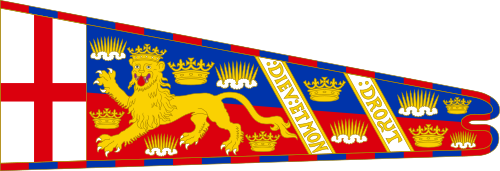 |
The St George's Cross is at the front. The flag has blue and red sections. It shows a crowned Lion of England and symbols like crowns and clouds. The motto DIEU ET MON and DROYT is split across the flag. |
 |
Richard II |  |
The St George's Cross is at the front. The flag is white and green. It features a White Hart (a white deer) with a gold chain around its neck. There are also four suns shining brightly. The motto DIEU ET MON and DROYT is split. |
 |
Henry V |  |
The St George's Cross is at the front. The flag is white and blue. It shows a white Swan with its wings spread, wearing a gold chain. There are also tree stumps on the flag. The motto DIEU ET MON and DROYT is split. |
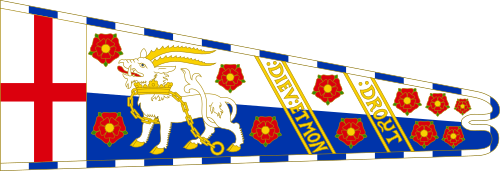 |
The St George's Cross is at the front. The flag is white and blue. It features a white Antelope with a gold chain. There are also red roses on the flag. The motto DIEU ET MON and DROYT is split. | ||
 |
Edward IV | 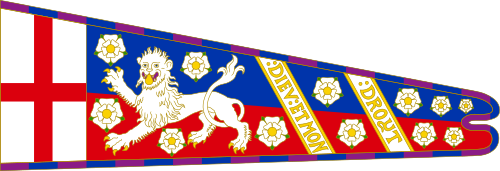 |
The St George's Cross is at the front. The flag is blue and red with a dark red and blue border. It shows a White Lion of March and white roses. The motto DIEU ET MON and DROYT is split. |
 |
The St George's Cross is at the front. The flag is blue and red with a dark red and blue border. It features the White Rose of York, shining with gold. The motto DIEU ET MON and DROYT is split. | ||
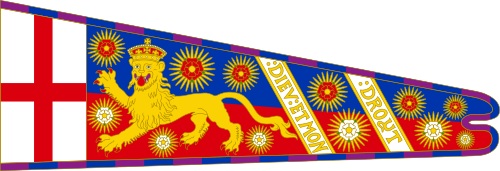 |
The St George's Cross is at the front. The flag is blue and red with a dark red and blue border. It shows a crowned Lion of England, with red and white roses. The motto DIEU ET MON and DROYT is split. | ||
 |
Richard III | 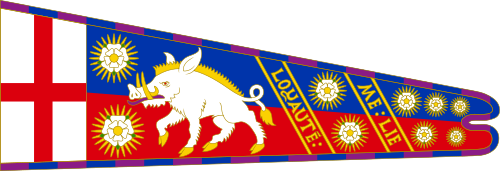 |
The St George's Cross is at the front. The flag is blue and red with a dark red and blue border. It features the White boar of Richard III and white roses. The motto LOYAUTE and ME LIE is split. |
 |
Henry VII | 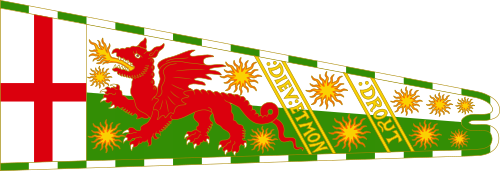 |
The St George's Cross is at the front. The flag is white and green. It shows a red Welsh Dragon with flames. The motto DIEU ET MON and DROYT is split. |
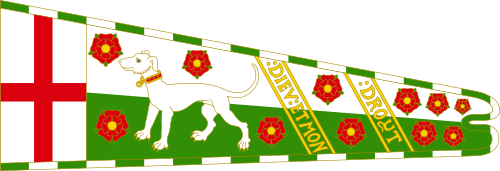 |
The St George's Cross is at the front. The flag is white and green. It features a white White Greyhound of Richmond with a red collar, surrounded by red roses. The motto DIEU ET MON and DROYT is split. | ||
 |
The St George's Cross is at the front. The flag is blue and red. It shows a crowned Lion of England, covered with Tudor roses and Fleurs-de-lys (lily symbols). | ||
 |
The St George's Cross is at the front. The flag is white and green with a dark red and blue border. It shows a red Dragon with red and white roses. The motto DIEU ET MON and DROYT is split. | ||
 |
The St George's Cross is at the front. The flag is white and green. It features a white White Greyhound of Richmond with a red collar. The flag is covered with Tudor roses, Portcullises (gate symbols), and Fleurs-de-lys. | ||
 |
Henry VIII | 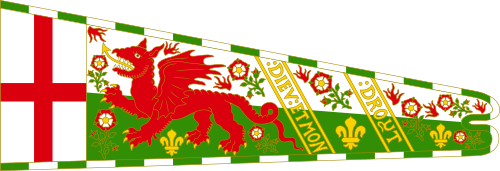 |
The St George's Cross is at the front. The flag is white and green. It shows a red Dragon, covered with Tudor roses, flames, and Fleurs-de-lys. |
 |
Charles I |  |
This was a large red, pennon-shaped flag. It had a St George's Cross near the staff, then the Royal Arms with a hand pointing to a crown. It also had the phrase: "GIVE UNTO CAESAR HIS DUE" and two other crowns with lions. This flag was raised in Nottingham in 1642. |
 |
Oliver Cromwell | 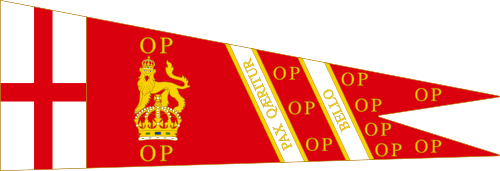 |
This standard had a white square with a red St George's Cross at the front. The rest of the flag was red and showed a crowned Lion of England standing on a crown. It also had the motto of the Commonwealth: "PAX QÆRITUR BELLO" (Peace is sought by war). This flag was only used at his funeral in 1658. |
See also



